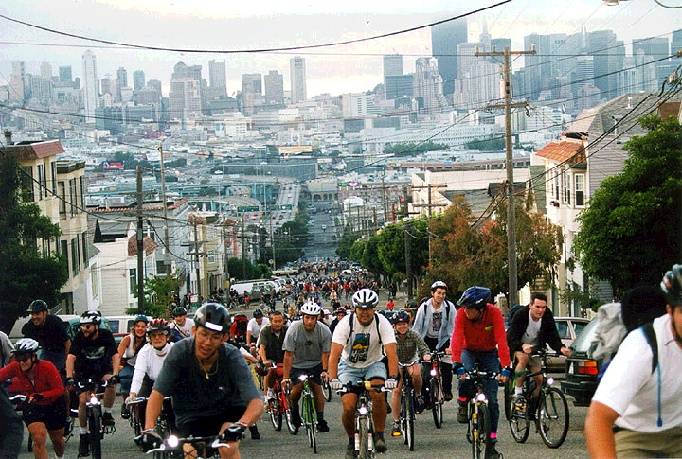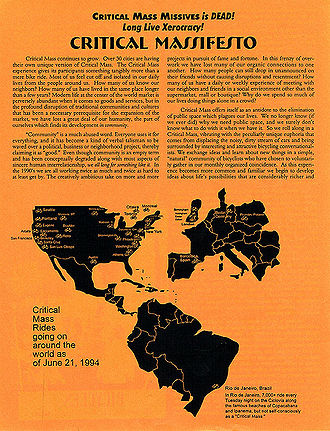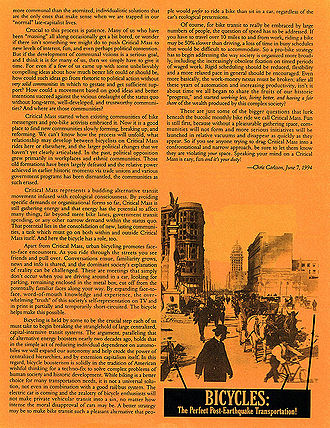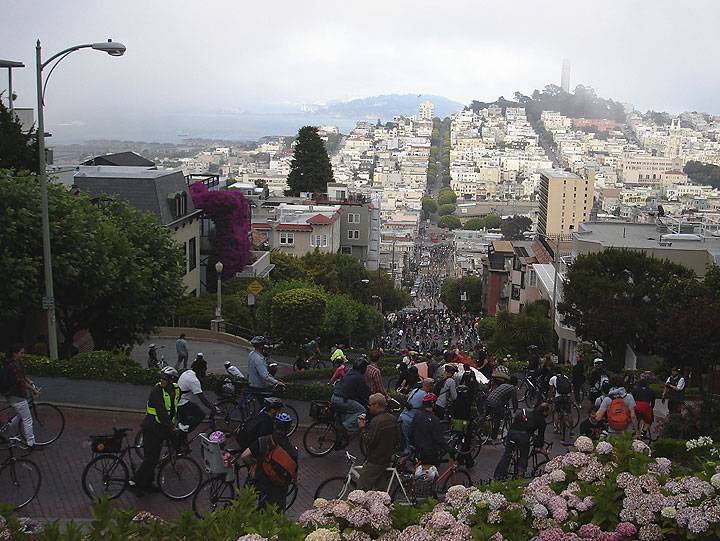Critical Massifesto
Historical Essay
--Chris Carlsson, June 7, 1994
August 1999: 2,000 Critical Massers go up Potrero Hill and down Vermont Street, the "real" curviest street in SF!
Photo: Chris Carlsson
Critical Mass continues to grow. Over 30 cities are having their own unique version of Critical Mass. The Critical Mass experience gives its participants something tangibly more than a mere bike ride. Most of us feel cut off and isolated in our daily lives from the people around us. How many of us know our neighbors? How many of us have lived in the same place longer than a few years? Modern life at the center of the world market is perversely abundant when it comes to goods and services, but in the profound disruption of traditional communities and cultures that has been a necessary prerequisite for the expansion of the market, we have lost a great deal of our humanity, the part of ourselves which finds its development in community.
"Community" is a much abused word. Everyone uses it for everything, and it has become a kind of verbal talisman to be waved over a political, business or neighborhood project, thereby claiming it as "good." Even though community is an empty term and has been conceptually degraded along with most aspects of sincere human interrelationship, we all long for something like it. In the 1990's we are all working twice as much and twice as hard to at least get by. The creatively ambitious take on more and more projects to make contributions to daily life and culture in pursuit of fame and fortune. In this frenzy of overwork we have lost many of our organic connections to one another. How many people can still drop in unannounced on their friends without causing disruptions and resentment? How many of us have a daily or weekly experience of meeting with our neighbors and friends in a social environment other than the supermarket, mall or boutique? Why do we spend so much of our lives doing things alone in a crowd?
Critical Mass offers itself as an antidote to the elimination of public space which plagues our lives. We no longer know (if we ever did) why we need public space, and we surely don't know what to do with it when we have it. So we roll along in a Critical Mass, vibrating with the peculiarly unique euphoria that comes from displacing the noisy, dirty stream of cars and being surrounded by interesting and attractive people. We exchange ideas and learn about new things in a simple, "natural" community of bicyclists who have chosen to voluntarily gather in our monthly organized coincidence. As this experience becomes more common and familiar we begin to develop ideas about life's possibilities that are considerably richer and more communal than the atomized, individualistic solutions that are the only ones that make sense when we are trapped in our "normal" late-capitalist lives.
Crucial to this process is patience. Many of us who have been "massing" all along occasionally get a bit bored, or wonder if there isn't something we might do to push Critical Mass to new levels of interest, fun, and even perhaps political contention. But if the development of communal visions is a serious goal, and I think it is for many of us, then we simply have to give it time. For even if a few of us came up with some unbelievably compelling ideas about how much better life could or should be, how could such ideas go from rhetoric to political action without very solid communities in which to gestate and get sufficient support? How could a movement based on good ideas and better intentions succeed against the vicious onslaught of the status quo without long-term, well-developed, and trustworthy communities? And where are those communities?
Critical Mass is a good place to find new communities slowly forming, breaking up, and reforming. We can't know how the process will unfold, what relationship may develop between bicyclists on Critical Mass rides here or elsewhere, and the larger political changes that we haven't yet clearly articulated. In the past, political opposition grew primarily in workplaces and ethnic communities. Those old formations have been largely defeated and the relative power achieved in earlier historic moments via trade unions and various government programs has been dismantled, the communities as such erased.
Critical Mass represents a budding alternative transit movement infused with ecological consciousness. By avoiding specific demands or organizational forms so far, Critical Mass is still gathering energy and that energy has the potential to affect many things, far beyond mere bike lanes, government transit spending, or any other narrow demand within the status quo. That potential lies in the consolidation of new, lasting communities, a task which must go on both within and outside Critical Mass itself. And here the bicycle has a role, too.
Apart from Critical Mass, urban bicycling promotes face-to-face encounters. As you ride through the streets you see friends and pull over. Conversations ensue, familiarity grows, news and info is shared, and the dominant society's explanation of reality is shaken. These are meetings that simply don't occur when you are driving around in a car, looking for parking, remaining enclosed in the metal box, cut off from the potentially familiar faces along your way. By expanding face-to-face, word-of-mouth knowledge and experience, the univocal, self-referential spectacle is partially and temporarily short-circuited. Thus, the bicycle is an anti-spectacular device.
Bicycling is held by some to be the crucial step each of us must take to begin breaking the stranglehold of large centralized, capital-intensive transit systems. The argument, paralleling that of alternative energy boosters nearly two decades ago, holds that in the simple act of reducing individual dependence on automobiles we will expand our autonomy and help erode the power of centralized hierarchies, and by extension capitalism itself. In this regard, bicycle boosterism is solidly in the tradition of American wishful thinking for a techno-fix to solve complex problems of human society and historic development. While biking is a better choice for many transportation needs, it is not a universal solution, not even in combination with a good rail/bus system. The electric car is coming and the zealotry of bicycle enthusiasts will not make private vehicular transit into a sin, no matter how intense the moral disapproval of cars may be. A better strategy may be to make bike transit such a pleasant alternative that people would prefer to ride a bike than sit in a car, regardless of its ecological pretensions.
Of course, for bike transit to really be embraced by large numbers of people, the question of speed has to be addressed. If you have to travel more than 10 miles to and from work, riding a bike may be 50% slower than driving, a loss of time in busy schedules that would be difficult to accommodate. So a pro-bike strategy has to begin addressing the way society is organized more broadly, including the increasingly obsolete fixation on timed periods of waged work. Rigid scheduling should be reduced, flexibility and a more relaxed pace in general should be encouraged. Even more basically, the work-money nexus must be broken; after all these years of automation and increasing productivity, isn't it about time we all began to share the fruits of our historic "progress," and started working less, living better, and having a fair share of the wealth produced by this complex society?
These are just some of the bigger questions that lurk beneath the bucolic monthly bike ride we call Critical Mass. Fun is still first, because without a pleasurable gathering space, communities will not form and more serious initiatives will continue to be launched in relative vacuums and disappear as quickly as they appear. So if you see anyone trying to drag Critical Mass into a confrontational and narrow approach, be sure to let them know they are violating your space. Speaking your mind on a Critical Mass is easy, fun and it's your duty!
<iframe src="https://archive.org/embed/ssfCMLOMBRD" width="640" height="480" frameborder="0" webkitallowfullscreen="true" mozallowfullscreen="true" allowfullscreen></iframe>
Down Lombard
Video: Super 8 film by Jim Swanson
Down Lombard during Critical Mass in July 2007.
Photo: Chris Carlsson




